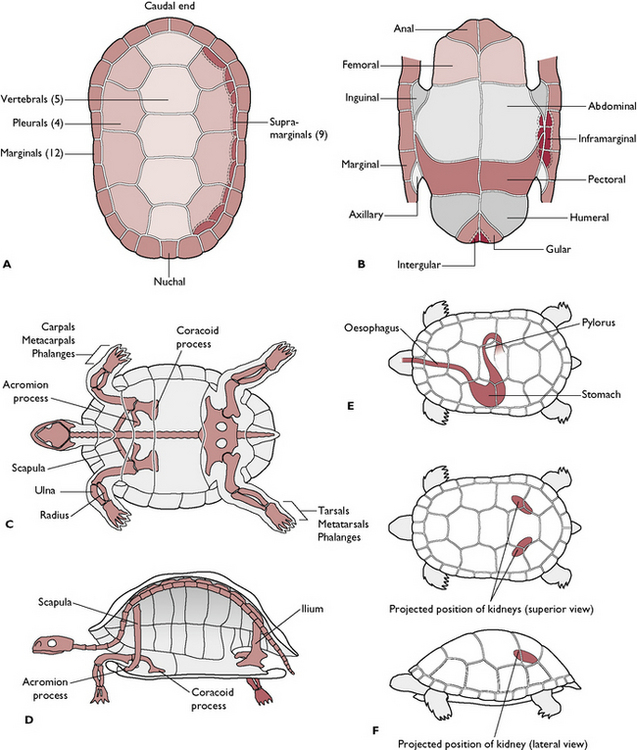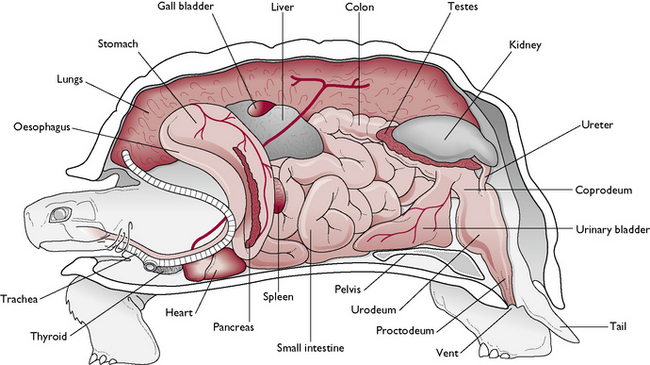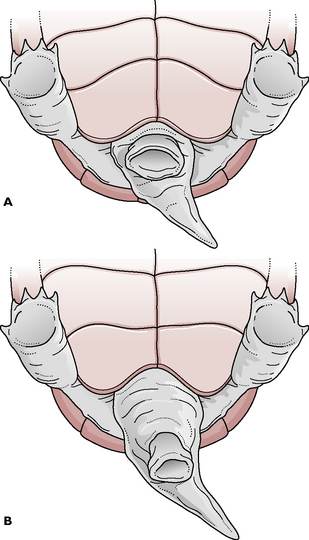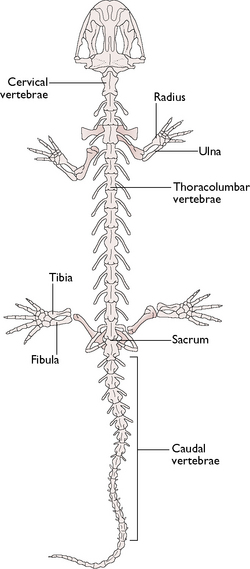Chapter 15 Reptiles and fish
REPTILES
The class Reptilia includes about 6500 species, all of which breed on land. The class is divided into four orders of which only two are significant as far as exotic pets are concerned. The four orders are:
General anatomy
The integument
The skin of reptiles is thick and keratinised and is protected by scales or horny plates. Reptiles grow by a process known as ecdysis, during which they shed or slough the old skin. Beneath this is a new layer, which, to start with, is quite soft and easily damaged. Ecdysis varies with species and may be partial shedding, as seen in lizards, or entire, as seen in snakes.
Tortoises, terrapins and turtles
Tortoises, turtles and terrapins are members of the order Chelonia (N.B. in the USA all shelled reptiles are referred to as turtles). They are characterised by a hard outer shell consisting of a domed upper part called the carapace and a flatter ventral part called the plastron (Fig. 15.1). The shell forms a bony ‘box’ that protects the soft internal parts of the body. The shell is covered with horny plates or scutes, which are named according to the most adjacent part of the body. The scutes grow from the outside so that an annual ring develops along the periphery of each one, making the overall shell larger. In some species these ‘growth rings’ can be used to estimate age.
Anatomical features
Skeleton
Chelonians are vertebrates and their skeleton resembles that of other vertebrates. However, the pectoral and pelvic girdles are within the rib cage and are orientated vertically to buttress the shell (Fig. 15.1). The ten vertebrae form part of the under surface of the carapace.
Respiratory system
The rigid outer shell of chelonians prevents the body wall from expanding during breathing. Respiration is accomplished with the aid of limb and head movements, which move in and out and alter the internal pressure in the body cavity. Chelonians breathe through their external nares or nostrils, so mouth breathing may indicate a respiratory problem. The glottis lies at the base of the tongue, and the trachea is short, which allows the tortoise to breathe when the neck is withdrawn. The lungs are positioned dorsally, below the carapace, and aid buoyancy in aquatic species (Fig. 15.1).
Digestive system
Chelonians do not have teeth and depend on their horny beak to cut off pieces of food. They have large, fleshy tongues that cannot protrude from the mouth. The oesophagus runs down the left side of the neck and joins the stomach, which lies transversely across the body (Fig. 15.2). The small intestine is relatively short (compared to mammals) and the colon ends in the cloaca, which is the common chamber into which the urogenital and digestive systems empty.
Urogenital system
In chelonians the ureters conduct relatively unconcentrated urine from the kidneys into a thin-walled urinary bladder (Fig. 15.2). Male chelonians possess a single, large penis that protrudes from the floor of the cloaca.
Lizards
Anatomical features
Skeleton
The skeleton of the lizard follows the basic vertebrate plan, but there is no sternum (Fig. 15.4). Most lizards have four legs and most species take their weight on all their legs, however some species, e.g. the basilisk, can run on two legs. The anatomy of the limbs indicates the mode of locomotion.
< div class='tao-gold-member'>
Stay updated, free articles. Join our Telegram channel

Full access? Get Clinical Tree






